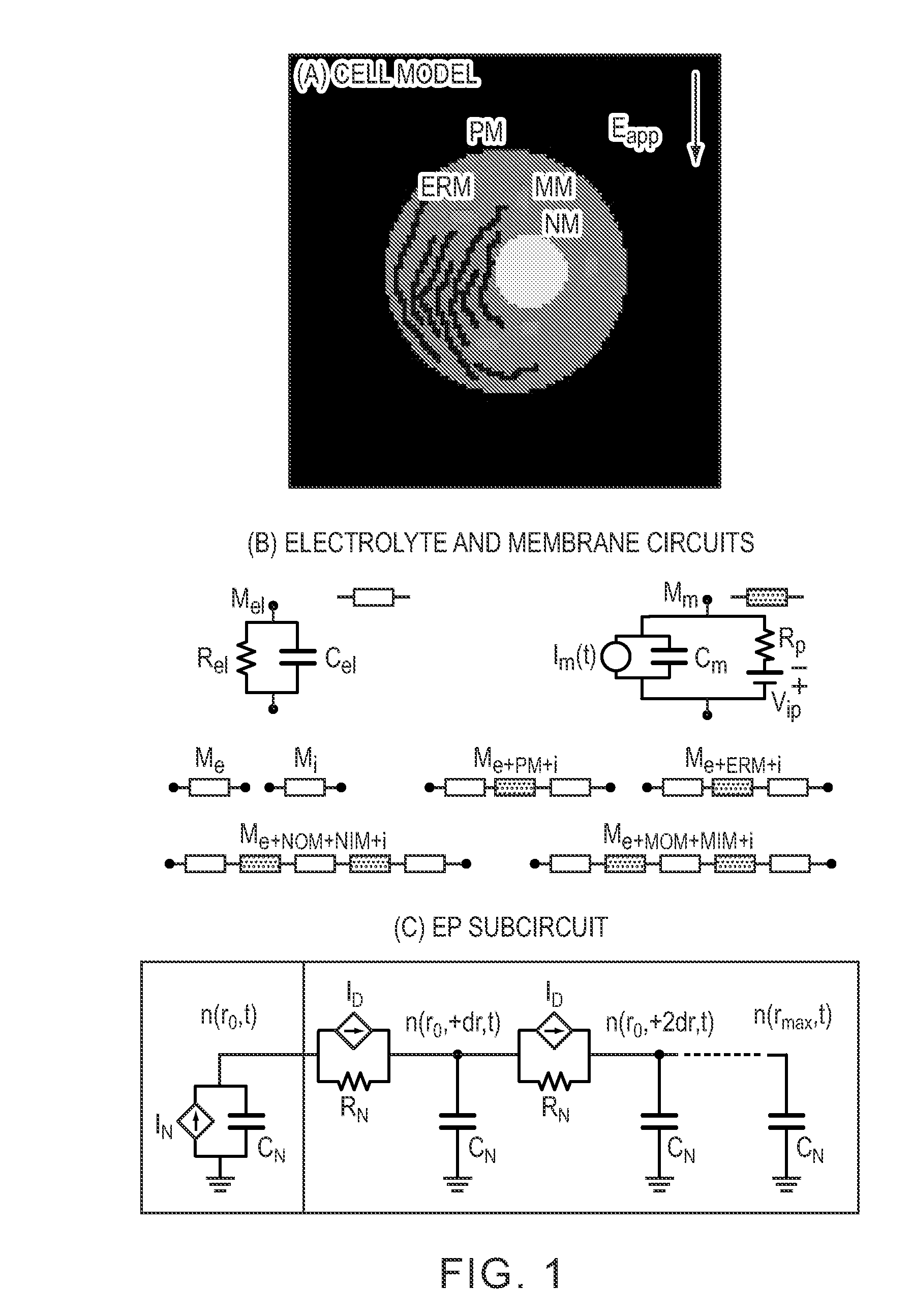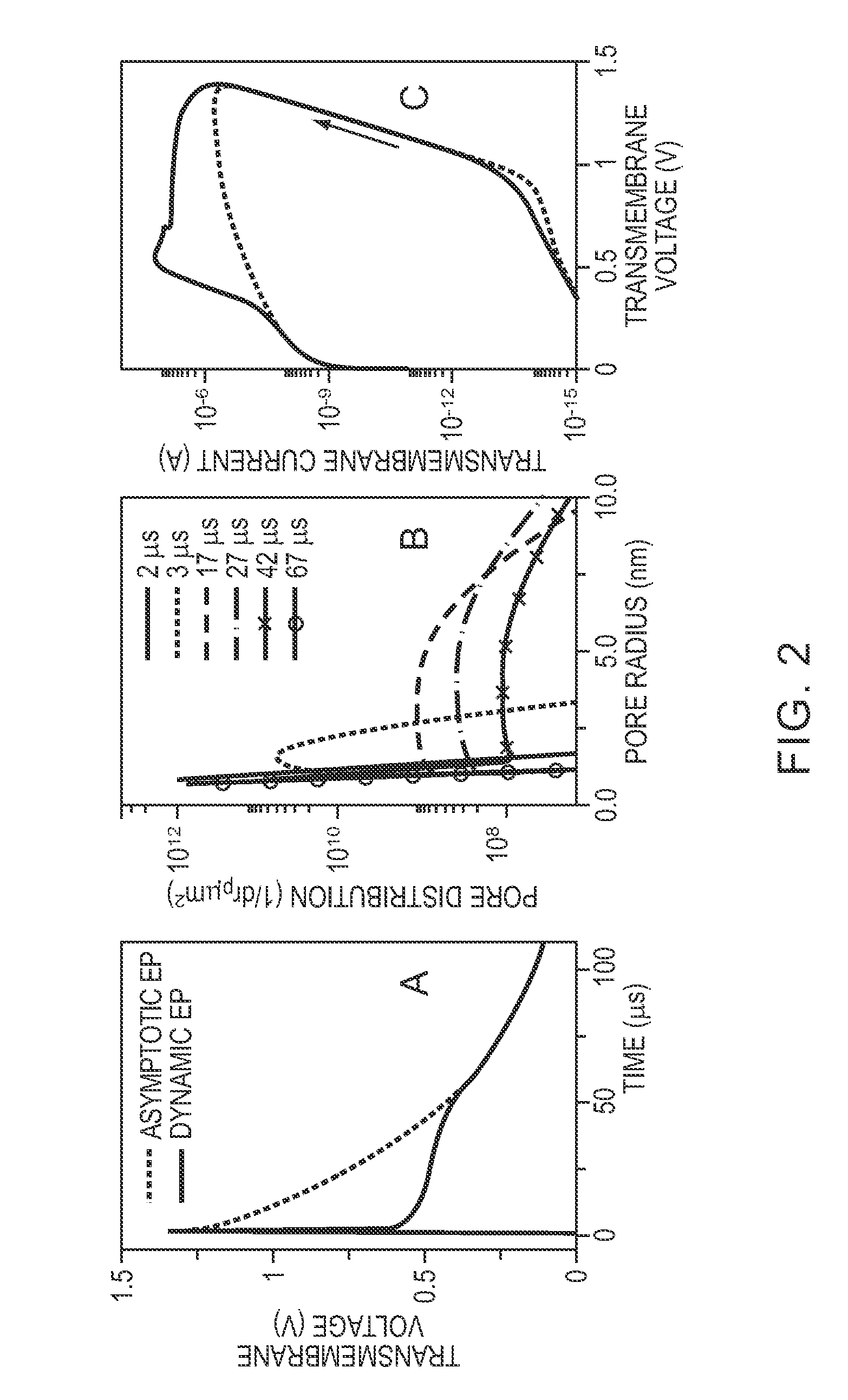Methods to treat unwanted tissue with electric pulses
a technology of electric pulses and unwanted tissue, applied in the field of medical treatments, can solve the problems of indirect methods that cause apoptosis upstream of dna damage via transcription factor p53, and hinder physical therapies such as localized ionizing radiation and systemic pharmaceutical interventions, and achieve the effect of preventing apoptosis and preventing apoptosis
- Summary
- Abstract
- Description
- Claims
- Application Information
AI Technical Summary
Benefits of technology
Problems solved by technology
Method used
Image
Examples
example 1
Cell and Organelle Electropermeabilization and Molecular Transport Through Dynamic Nanopores
[0090]To study the action of electromagnetic fields in biological systems, cell and tissue membranes are often characterized by passive conductive and dielectric properties. Conventional EP pulses involve characteristic times (pulse duration, rise and fall times) that exceed the PM charging time τPM, which is typically 0.1 to 1 μs, for mammalian cells in suspension. If the passive models were sufficient, then the cell interior would be essentially shielded from the external electric field as the PM is completely polarized for exposure times exceeding τPM. However, this conclusion neglects nanoscale membrane reorganizations associated with the process of EP, a robust and universal mechanism by which cells, depending on their size, respond to electric fields of magnitudes larger than about 104 V / m. EP is widely used in biological research and is also a tool for several medical interventions. Ex...
example 2
Activation of Apoptosis by Electrical Release of Death Molecules from Mitochondria
[0137]Mathematical modeling shows that appropriate electrical pulses can directly create transient phospholipid MOM pores by electroporation (MOMEP), producing a nearly instantaneous, physically driven MOM permeabilization (MOMP) and therefore bypassing the biochemical signaling cascade. The mechanism quantitatively describing dynamic pore distributions that allow sufficient cyt-c release and irreversible caspase activation for experimental conditions that cause electrically induced apoptosis is shown. A direct physical method to induce apoptosis by electrical MOMP (FIG. 9) is shown.
[0138]FIG. 9 shows apoptosis by MOMEP. Strong electric field pulses, by electroporating the plasma membrane (PMEP), cause large intracellular electric fields that can lead to organelle EP such as MOMEP. Electrophoretic cyt-c efflux through transient phospholipid MOM pores activates caspases and the mitochondrial apoptosis p...
example 3
Screening Waveforms In Silico for Mitochondria Membrane Electroporation-Induced Apoptosis
[0158]A transport lattice (TL) method can be used to generate equivalent cell system models with two, three, or more cells in two dimensions (2D). These models can be easily extended to comprise many cells of a tissue, and in particular cells of different sizes. These models can also be combined with large scale tissue models to determine an intracellular electric condition in large scale tissue models and then to combine these intracellular electric conditions with cell system to obtain the number of death molecules released due to a particular electric field waveform. This method thus provides a means to generate a plurality of different waveforms, with different shape, duration, and field strength, and to select a particular waveform that leads to a specific intracellular electric field, which for example, leads to a specific number of released death molecules, for example cytochrome-c, to in...
PUM
 Login to View More
Login to View More Abstract
Description
Claims
Application Information
 Login to View More
Login to View More - R&D
- Intellectual Property
- Life Sciences
- Materials
- Tech Scout
- Unparalleled Data Quality
- Higher Quality Content
- 60% Fewer Hallucinations
Browse by: Latest US Patents, China's latest patents, Technical Efficacy Thesaurus, Application Domain, Technology Topic, Popular Technical Reports.
© 2025 PatSnap. All rights reserved.Legal|Privacy policy|Modern Slavery Act Transparency Statement|Sitemap|About US| Contact US: help@patsnap.com



